Fala Português? Fala Chines? You don’t need to know either language to understand what the 2018 AJP PR4 Enduro 240 is all about, but it doesn’t hurt to know that both countries—Portugal and China—have a hand in the PR4’s existence.
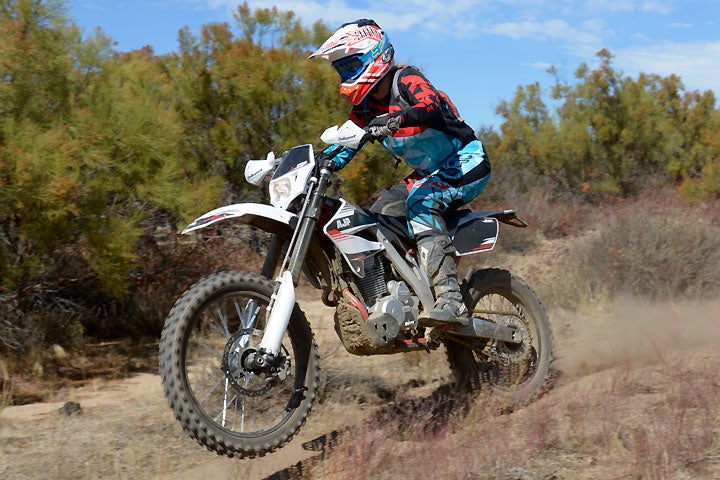
Depending on your perspective, the AJP PR4 Enduro 240 may be another example of global manufacturing, or just one company’s route to building a cheap dirtbike. But, however you view it, the AJP PR4 Enduro 240 is a high-value proposition for dirtbike beginners and cowtrailers in the 2018 AJP lineup. With an MSRP of just $4999, the PR4 is intended to be an affordable, easy-to-maintain off-road motorcycle that blurs the line between your average playbike and your all-out, enduro-oriented off-road machine.
The AJP brand name is derived from the initials of Antonio J. Pinto, the seven-time Portuguese National Enduro Champion who founded the company about 30 years ago. Assembled in the company’s plant in Penafiel in northern Portugal, the AJP PR4 Enduro 240 mates AJP’s unique chassis, which features a chrome-moly steel downtube mated to a cast aluminum mid-section to which the AJP’s gorgeous polished aluminum swingarm and chrome-moly steel subframe are attached, to a Chinese-made engine. Power comes from a 233cc, air-cooled, SOHC, two-valve, four-stroke that bears a strong resemblance to a Honda CRF230R engine. Only instead of a Honda, the AJP engine is manufactured by Zongshen. Electric start is standard, and the PR4 actually carries switchgear that allows it to be fitted with turn signals for road use in countries where it is legal. That doesn’t currently include the U.S., where the AJP PR4 Enduro 240 is neither DOT-legal for the higway nor EPA-legal for public land. That’s something to consider, depending upon where you live.
AJP isn’t the first cottage manufacturer to embrace the aftermarket in order to add value to its machines. The PR4 hosts a few name-brand pieces, even if you’ve never heard of some of them before now. For instance, the PR4’s billet aluminum triple clamp holds a FastAce 43mm USD fork that is compression and rebound adjustable; FastAce is better known for manufacturing quality mountain bike forks. Out back is a fully adjustable shock is from Sachs of Germany, the same manufacturer that supplies suspension components for such OEMs as Beta and Gas Gas (although the latter has switched to KYB for 2018). An FMF Racing muffler, Reikon tapered aluminum handlebar, Shorai battery and Spectro oil are all trumpeted as standard equipment on the AJP PR4 Enduro 240.
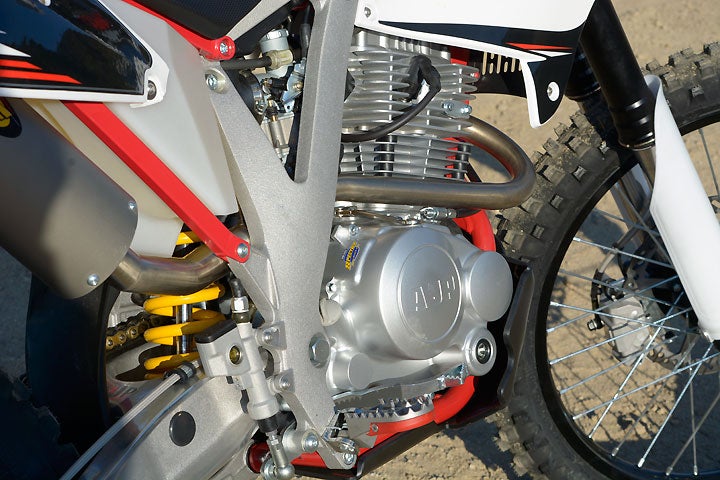
Firing up the AJP is as simple as turning on the ignition key and thumbing the starter button. Cold starts are made easier by lifting up the side-mounted choke lever on the PR4’s Keihin/Deni PZ30 carburetor, which features an accelerator pump to minimize hesitation and improve response during hard acceleration. That said, hard acceleration is not something you’re likely to find when you go through the gears on the PR4. With its old-school engine architecture and under-square, 60.0mm bore and 62.5mm stroke, the 233cc Zongshen mill doesn’t whip up a lot of horsepower, but what it does serve is smooth and linear, although not zingy. On the dyno, our PR4 test rig squeezed out a max horsepower reading of 14.6 rwhp at 6700 rpm and a maximum torque reading of 12.55 lb.-ft. at 5200 rpm. Those are pretty wheezy figures by modern standards, but they’re perfectly acceptable within the realm of playbikes such as the Honda CRF230R and Yamaha TT-R225. We enlisted veteran motojournalist and DirtBikes.com guest tester Jean Turner to swing a leg over the PR4, and she offered the following take on the AJP: “I don’t know if it’s exactly down on power, or if it’s the nature of the power–very soft, slow to build, fluffy when you crack the throttle. Definitely not responsive, which makes it feel lazy. And yet it chugs right along once you get it into the power.”
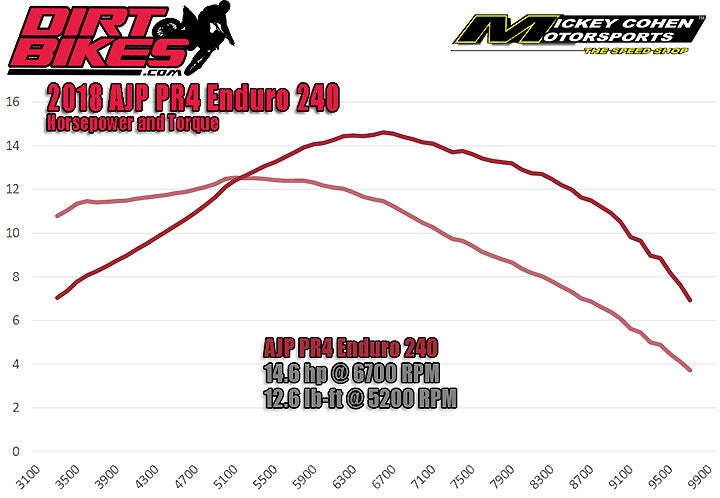
True enough, and that’s just the kind of power delivery that first-time riders, young or old, will appreciate. The PR4 is content to just hum along, the bark of its FMF muffler belting out a tune that makes the PR4 sound brawnier than it really is. On the plus side, what little lunge the engine makes is distributed across a wide rev range, with the engine making 10 lb-ft. of torque as low as 3300 rpm and maintaining it for over 4000 rpm before tapering off ever so gently as the engine slowly climbs to its 9800 rpm rev ceiling. In technical terrain, the PR4 doesn’t have enough snap to loft the front wheel over a log or a rock, but it has more than enough grunt and tractability to roll up and over it.
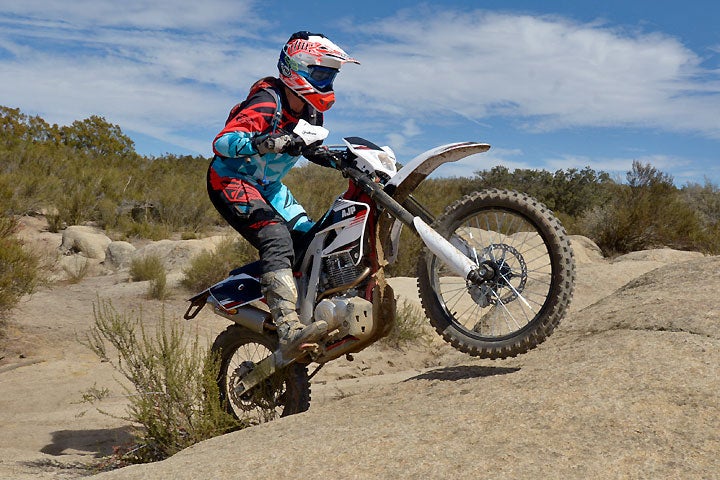
And still, the PR4 can be ridden pretty quickly, especially in tight terrain, thanks to its well-spaced five-speed transmission. In keeping with its bare bones theme, the PR4 also features a cable-operated clutch rather than a hydraulically assisted unit. Clutch action is smooth enough, but we noticed that the clutch has a tendency to wear quickly under what we could consider to be not a lot of abuse by experienced riders. Fortunately, when the lever does creep toward the handlebar, adjusting the play out of the cable is a simple matter of turning the over-sized adjuster knob that is located on the clutch perch.
Turner felt that the transmission’s shifting action left something to be desired. “Shifting is very clunky and notchy,” she said. “It takes a very deliberate movement of the whole foot/leg to get from first to second gear without stumbling on neutral. I could see this messing up a beginner rider quite easily, but I also suspect this is just a break-in problem. As long as you have an experienced rider who can break it in, you can hopefully remedy that problem before it trips up less experienced riders.”
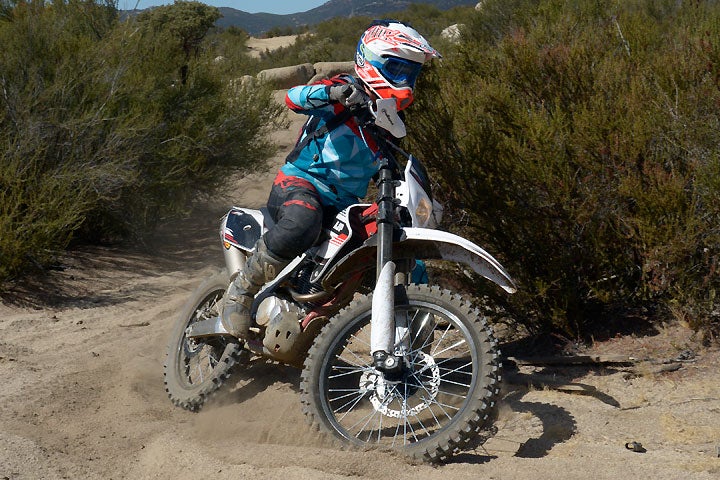
On the other hand, while the engine performance may seem archaic to more experienced riders, the PR4 Enduro 240’s chassis performance is downright impressive. The entire PR4 package weighs 250.2 lbs.—a tenth of a lb., more than the 2018 Suzuki RM-Z450—with its midship-mounted 1.8-gallon fuel cell filled to capacity, and yet it does a good job of spreading its weight across the entire chassis to make the PR4 seem lighter than it really is despite its lack of modern-style power. We tried riding the PR4 extremely fast in desert conditions and also in cramped, tight and rocky conditions, and the chassis never let us down. The PR4 just kept on feeling groovy.
“The tipping point [center of gravity] seems to be pretty low, which is another good thing for beginners,” Turner said. “They are going to wobble and struggle with balance at some point, and you need as big a window as possible to allow them to figure out control. The Japanese bikes have a very small window here. I feel like the AJP will be more forgiving.”
Not only that, but the AJP chassis is competent enough that riders can ride it even harder as they gain experience. Even a couple of our pro-level testers expressed pleasure at just how well the PR4 steers, even on loose or slippery ground. Its 27-degree rake and 5.5-inch trail figures are close to the average motocross bike, and that helps to give the PR4 quick and razor-sharp steering manners. All it takes to change direction is a mere nod of the head toward where you want to go, and the AJP will respond with excellent front-end traction, which only adds to rider confidence. Straight-line stability is also excellent. We pushed the PR4 chassis as hard as we could with the available power we had, and we couldn’t get it to do anything stupid or unpredictable.
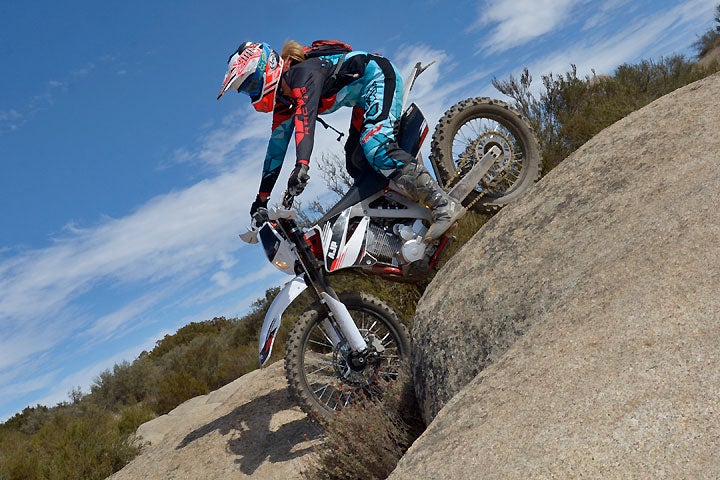
“The front definitely sticks like Velcro and tracked surprisingly well even in sand,” Turner said. “This is another big plus for beginner riders. The AJP handles quite nicely on the trail. The chassis is far more responsive than the motor. If you could add more power to that mix… I’m sure lively power would make it feel much lighter and even more agile on the trail. It’s stable, turns well, and the suspension seems pretty well suited for more aggressive riding.
Indeed, we found little wrong with the AJP PR4 Enduro 240 suspension. While we didn’t spend a lot of time dialing them in, we didn’t really have to in order to make them work well at the speeds of which the PR4 is capable. Neither end delivers the plushest ride we’ve experienced, but we still rate it as good. Boasting 10.5 inches of travel, the FastAce fork is able to handle small chop well while doing a decent job of withstanding spike hits from rocks and tree roots, especially at lower speeds. Out back, we noticed the rear end to be a little less willing to follow every ripple on the trail, but with 11.8 inches of travel, it offered plenty to soak up big hits with relative competence. Truth be told, we think that the PR4 has decent suspension for playbike riding and even some racing.
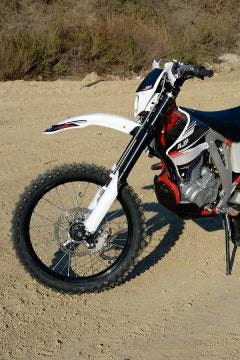 “I was surprised by the suspension,” Turner said. “In our photoshoot, when I was dropping down little rock faces, I wasn’t sure if the fork was going to bottom. I feel that a TT-R125 or a KLX140 would have clacked on a little drop-off like that, or on some square edges or whoops when we went for our little trail ride.”
“I was surprised by the suspension,” Turner said. “In our photoshoot, when I was dropping down little rock faces, I wasn’t sure if the fork was going to bottom. I feel that a TT-R125 or a KLX140 would have clacked on a little drop-off like that, or on some square edges or whoops when we went for our little trail ride.”
One aspect that our testers raved about, from Pro rider Nick Stover on down, was the AJP PR4 Enduro 240’s ergonomics. AJP clearly has a handle on chassis design and ergos, and the PR4 is proof of that. Its narrow cockpit feels small but not cramped. Most of our riders agreed that the PR4 feels small and slim through the middle despite the bulky appearance of its aluminum chassis section. And, with no fuel tank bulge up front, the AJP’s long and narrow seat allows the rider to move freely fore and aft. The AJP is also equally comfortable whether the rider is seated or standing. Transitioning from one to the other is no problem at all.
“I think the seat is going to win a lot of approval from beginners,” Turner said. “It’s soft and squishy and wide enough toward the rear (narrower up front). Anything that can add comfort to an unfamiliar situation carries big bonus points. I think experienced riders forget how intimidating it can be to swing a leg over a bike for the first time. But when someone sits on the AJP for the first time in the dealership, they are going to find it comfortable and lightweight (even just rocking side to side at a standstill) with an easy reach to the ground. When that initial feel is comfortable, I think you’ve already gone a long way toward getting people engaged and interested in riding motorcycles!”
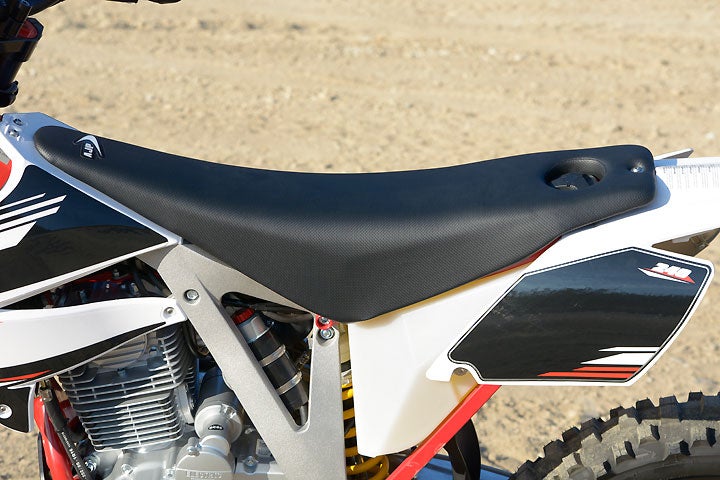
And once again, where other “playbike models” often come equipped with a front disc brake and a chintzy rear drum brake, the front/rear discs on the AJP PR4 Enduro 240 are another quality touch. The PR4 comes equipped with a 260mm front disc with a two-piston caliper and a 220mm rear disc with a single-piston caliper. The PR4 also comes with quality Michelin tires instead of some off-the-wall Asian brand. The brakes deliver excellent power front and rear, although we noted that the front brake lever had a slightly wooden feel while the rear brake pedal was tucked in too tightly to the PR4, requiring us to bend the pedal out a bit so that we could catch it satisfactorily with our boot.
Overall, we think that the AJP PR4 Enduro 240 is a pretty good bike, and our biggest concern in making a purchase would be finding a dealer who is well in tune with the brand, and that might be tough when the brand is still new to America. A good dealer with a good parts supply can make all the difference in the ownership experience of any model. Of course, AJP knows that, so the company has already implemented programs such as its 2Easy 2Buy program to have a more direct relationship with its growing customer base.
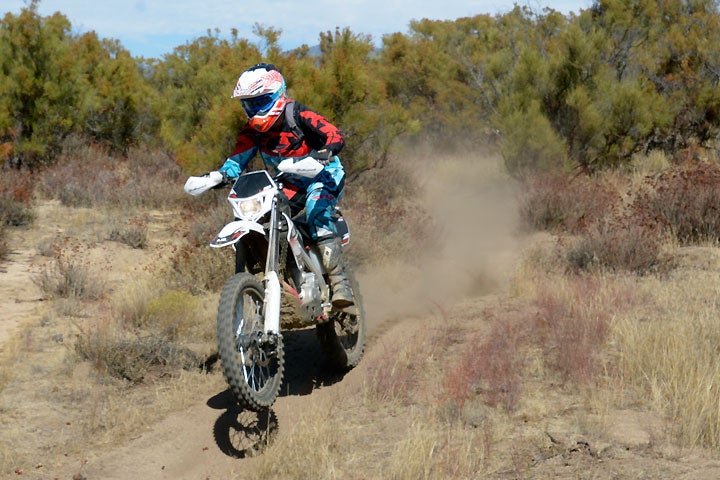
Regardless, as Turner puts it, “There’s plenty to like about this bike. It’s lightweight, comfortable and the chassis seems very solid. There are so many reasons to own a bike of this size, and there might be a reason or two why the AJP PR4 Enduro 240 is the best of the bunch: 1) It’s a great beginner bike for friends who want to try out trail riding; it’s a good adult-beginner size.; 2) It’s a great runabout for events; 3) It’s the perfect bike to ride around with your kids; it’s harder to do that on a full-size, fire-breathing MX or off-road bike; and, 4) It’s perfect for when the devil horns come out.
Congratulations, AJP. You’ve built one heck of a fun bike in the PR4 Enduro 240. Now how’s a about setting us up with one of your PR5R Extreme Enduro 250 for a long-term/race test. With more power, there’s no telling what one might be able to do with that sweet-handling AJP chassis.
2018 AJP PR4 Enduro 240 Specifications
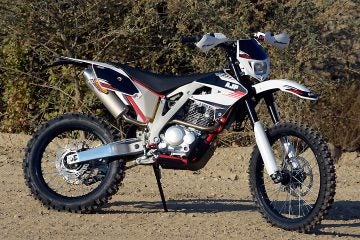 MSRP: $4999
MSRP: $4999
Engine Type: 233cc, air-cooled, single-cylinder, four-stroke
Bore: 60.0mm
Stroke: 62.5mm
Compression Ratio:
Valve Train: SOHC, two-valve cylinder head
Fueling: Keihin/Deni PZ30 carburetor w/accelerator pump
Ignition: 120W CDI
Transmission: Five-speed, multi-plate wet clutch
Final Drive: Chain, 13T/45T
Front Suspension: 43mm inverted FastAce fork with rebound and compression damping adjustability; 10.5 in. of travel
Rear Suspension: Progressive linkage, Sachs single shock with adjustable spring preload, rebound and compression damping adjustability; 11.8 in. of travel
Front Brake: Single 260mm disc w/two-piston caliper
Rear Brake: Single 220mm disc w/single-piston caliper
Front Tire: Michelin 90/100-21
Rear Tire: Michelin MX3S 120/80-18
Wheelbase: 54.3 in.
Rake: 27°
Trail: 140mm (5.5 in.)
Seat Height: 36.2 in. (35.2 in. w/supplied lowering link)
Ground Clearance: 13.2 in. (w/stock link)
Fuel Capacity: 1.8 gal.
Claimed Wet Weight (no fuel): 239 lbs.
Measured Wet Weight (full fuel): 250.2 lbs., 122.7 lbs. front (49%) front/127.5 rear (51%)
Available Colors: White/Black/Red
 Your Privacy Choices
Your Privacy Choices